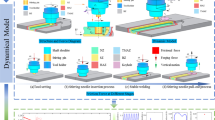Abstract
The operating modes of loading elements of machines and structures exhibit, as a rule, more complicated character of their loading cycles compared to sinusoidal used in the practice of calculations and experiments. It is noted that, in a number of cases, the actual conditions of load changing can be idealized by dual-frequency loading modes with superposition of the high-frequency component of the main workload attributed to the effects of vibrations, aero- and hydrodynamic impacts, regulation of the working process, etc. Testing of three steel samples with different cyclic properties has shown that such two-frequency regimes lead to a decrease in the durability in comparison with single-frequency loading equal in the amplitude of maximum stresses. This reduction depends on the parameters of the basic low-frequency and imposed high-frequency loads. Evaluation of this reduction can be performed both using the laws of summation of the damage expressed in the strain terms and using an analytical expression considered below, which includes the calculated or experimentally determined durability for single-frequency loading with the maximum (total) amplitude of the effective stress and the durability coefficient characteristic of each type of material and determined by the ratio of amplitudes and hours of low and high stresses. A computational-experimental analysis of the effect of the amplitude of low-frequency and superimposed high-frequency loading under two-frequency modes of stress change on the cyclic durability has shown that the imposition of the high-frequency component of cyclic deformation on the main low-cycle loading process leads to a significant decrease in the cyclic durability; the level of the decrease correlates with the level of ratios of amplitudes and frequencies of the summarized harmonic processes of load application.






Similar content being viewed by others
REFERENCES
Kogaev, V.P., Raschety na prochnost’ pri napryazheniyakh, peremennykh vo vremeni (Calculation for Strength under Different Loads), Moscow: Mashinostroenie, 1993.
Makhutov, N.A., Konstruktsionnaya prochnost’, resurs i tekhnogennaya bezopasnost’. Chast’ 1. Kriterii prochnosti i resursa (Construction Strength, Service Life, and Technogenic Safety. Part 1: Criteria of Strength and Service Life), Novosibirsk: Nauka, 2005.
PNAE (Rules and Norms of Nuclear Power Industry) G‑7-002-86: Strength Calculation Norms for Equipment and Pipelines of Nuclear Power Installations), Moscow: Energoatomizdat, 1989.
Makhutov, N.A. et al., Problemy prochnosti i bezopasnosti vodo-vodyanykh energeticheskikh reaktorov (Strength and Safety of Water-Cooled power Reactors), Issledovaniya napryazhenii i prohcnosti yadernykh reaktorov (Research of Stresses and Strength of Nuclear Reactors), Moscow: Nauka, 2008.
Makhutov, N.A. et al., Nesushchaya sposobnost’ parogeneratorov vodo-vodyanykh energeticheskikh reaktorov (Bearing Capacity of Steam Generators of Water-Cooled Power Reactors), Issledovaniya napryazhenii i prohcnosti yadernykh reaktorov (Research of Stresses and Strength of Nuclear Reactors), Moscow: Nauka, 2003.
Makhutov, N.A., Bezopasnost’ i riski: sistemnye issledovaniya i razrabotki (Safety and Risks: System Studies and Development), Novosibirsk: Nauka, 2017.
Bezopasnost’ Rossii. Pravovye, sotsial’no-ekonomicheskie i nauchno-tekhnicheskie aspekty. Funktsionirovanie i razvitie slozhnykh narodokhozyaistvennykh, tekhnichesksikh, energeticheskikh, transportnykh sistem, sistem svyazi i kommunikatsii. Razdel 1. Teoreticheskie osnovy bezopasnogo funktsionirovaniya slozhnykh tekhnicheksikh sistem (Safety of Russia. Legal, Social-Economic, and Scientific-Technical Aspects. Functions and Development of Complex Economic, Technical, Energetic, Transport Systems, Communication Systems, and Service Lines, vol. 1: Theory of Safe Functioning of Complex Engineering Systems), Moscow: Znanie, 1998.
Bezopasnost’ Rossii. Pravovye, sotsial’no-ekonomicheskie i nauchno-tekhnicheskie aspekty. Funktsionirovanie i razvitie slozhnykh narodokhozyaistvennykh, tekhnicheskikh, energeticheskikh, transportnykh sistem, sistem svyazi i kommunikatsii. Razdel 2. Obespechenie bezopasnogo funktsionirovaniya slozhnykh tekhnicheksikh sistem na raznykh etapakh zhiznennogo tsikla (Safety of Russia. Legal, Social-Economic, and Scientific-Technical Aspects. Functions and Development of Complex Economic, Technical, Energetic, Transport Systems, Communication Systems, and Service Lines, vol. 2: Maintenance of Safe Functioning of Complex Engineering Systems at Different Stages of Life Cycle), Moscow: Znanie, 1998.
Napryazhenno-deformirovannye sostoyaniya ZhRD (Stress-Strain States of Liquid-Fuel Rocket Engines), Issledovaniya napryazhenii i prohcnosti yadernykh reaktorov (Research of Stresses and Strength of Nuclear Reactors), Makhutov, N.A. and Rachuk, V.S., Eds., Moscow: Nauka, 2013.
Gadenin, M.M., Estimation of the effect of loading modes on the conditions of attainment of marginal states and resource assignment, Inorg. Mater., 2014, vol. 50, no. 15, pp. 1537–1542.
Gadenin, M.M., Study on damaging and fatigue life of constructions under single- and two-frequency loading modes based on deformational and energy approaches, Inorg. Mater., 2018, vol. 54, no. 15, pp. 1543–1550.
Makhutov, N.A. et al., Uravneniya sostoyaniya pri malotsiklovom nagruzhenii (Equations of the State in Low-Cycle Loading), Moscow: Nauka, 1981.
Gadenin, M.M., Peculiarities of strains evolution and damages accumulation at two-frequency low-cycle loading and heightened temperatures, Mashinovedenie, 1976, no. 1, pp. 69–77.
Makhutov, N., Romanov, A., and Gadenin, M., High temperature low-cycle fatigue resistance under superimposed stresses at two frequencies, Fatigue Eng. Mater. Struct., 1979, vol. 1, no. 3, pp. 281–285.
Gadenin, M.M., Resistance change to low-cycle deformation and fracture for two-frequency process of a loading, in Materialy XIII nauchno-tekhnicheskoi konferentsii “Problemy nadezhnosti i dolgovechnosti elementov konstruktsii v mahsinostroenii i stroiindustrii,” Tezisy dokladov (Proc. XIII Sci.-Tech. Conf. “Strength and Longevity of the Construction Elements in Machine Engineering and Building Industry,” Abstracts of Papers), Sverdlovsk: Sverdl. Obl. Sovet NTO, 1978, pp. 5–6.
Manson, S.S., Thermal Stress and Low-Cycle Fatigue, New York: McGraw-Hill, 1966.
Gadenin, M.M., Kinetics of strains and damages accumulation as a result of elastoplastic loading cycle form, Zavod. Lab.,Diagn. Mater., 2008, vol. 74, no. 10, pp. 61–65.
Funding
This work is supported by the Russian Foundation for Basic Research, project no. 18-08-00572_a.
Author information
Authors and Affiliations
Corresponding author
Additional information
Translated by L. Trubitsyna
Rights and permissions
About this article
Cite this article
Gadenin, M.M. Study of the Effect of Strain Amplitude Ratio at Two-Frequency Cyclic Loading. Inorg Mater 55, 1523–1532 (2019). https://doi.org/10.1134/S0020168519150056
Received:
Revised:
Accepted:
Published:
Issue Date:
DOI: https://doi.org/10.1134/S0020168519150056



